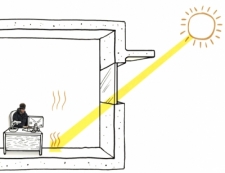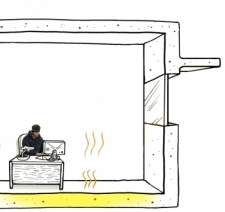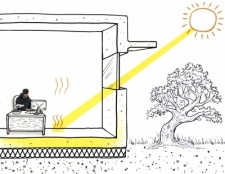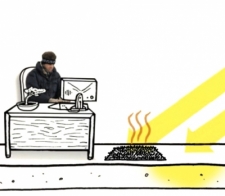You are here
Thermal mass is a material's resistance to change in temperature. Thermal mass is crucial to good passive solar heating design, especially in locations that have large swings of temperature from day to night.
|
Thermal mass can store energy absorbed from the sun and release it over time. Conversely, it can resist heating up too fast from solar radiation. |
Objects with high thermal mass absorb and retain heat, slowing the rate at which the sun heats a space and the rate at which a space loses heat when the sun is gone. Without thermal mass, heat that has entered a space will simply re-radiate back out quickly, making the space overly hot with sunlight and overly cold without.
Thermal mass has virtually no effect in steady-state heat flow, which is when temperatures are relatively constant on each side of a material.
Designing with Thermal Mass
Common architectural implementations of thermal mass storage are concrete floor slabs, water containers, and interior masonry walls such as the back of a chimney. However, many materials can be used.
Climates and Thermal Mass
Thermal mass is most useful in locations that have large swings of temperature from day to night, such as desert climates. Even if the thermal mass does not prevent heat energy from flowing into or out of occupied spaces, like insulation would, it can slow the heat flow so much that it helps people's comfort rather than causing discomfort.
 |
| Thermal mass captures and stores solar heat gain |
 |
| Thermal mass re-radiates heat after the sun is gone |
In climates that are constantly hot or constantly cold, the thermal mass effect can actually be detrimental. This is because all surfaces of the mass will tend towards the average daily temperature; if this temperature is above or below the comfortable range, it will result in even more occupant discomfort due to unwanted radiant gains or losses. Thus, in warm tropical and equatorial climates, buildings tend to be very open and lightweight. In very cold and sub-polar regions, buildings are usually highly insulated with very little exposed thermal mass, even if it is used for structural reasons.
Thermal Mass for Solar Gain
Thermal mass is often critical to direct solar gain passive design.
High thermal mass materials conduct a significant proportion of incoming thermal energy deep into the material. This means that instead of the first couple of millimeters of a wall heating up 5–10 degrees, the entire wall heats up only 1–2 degrees. The material then re-radiates heat at a lower temperature, but re-radiates it for a longer period of time.
This helps occupants stay more comfortable, longer. When the internal temperature of the space falls at night, there is more energy still stored within the walls to be re-radiated back out.
The larger the area of thermal mass receiving direct sunlight, the more heat it receives, so the faster it can heat up, and the more heat it can store.
|
Insulation prevents thermal gain from leaking into the ground |
|
Insulative coverings can interfere with thermal mass |
Thermal Conductivity with Thermal Mass
Insulation can be extremely valuable in preventing direct gain from being conducted to the ground or outside air, where it is lost. In hot climates where direct gain is not desirable, it can even be beneficial for external finishes to have low thermal mass, as well as low conductivity, to increase the effectiveness of insulation.
Thermal lag from mass can greatly reduce the need for insulation in the building envelope, especially in climates with large temperature swings from day to night. Combining thermal mass with insulation can avoid such unwanted temperature swings indoors, while still allowing solar heat gain or radiative cooling.
However, thermally conductive materials can be highly desirable inside a space. They will quickly transfer any heat buildup away from a surface struck by sunlight, deeper into the material, which both stores and evenly distributes the heat within the space. Whereas in less conductive materials, the surface will heat up more where the light strikes, creating a hotspot there while other parts of the space may be cold.
For example, a thick concrete floor will conduct heat and store it relatively evenly throughout the floor (though areas directly struck by the sun will be warmer). However, a wood floor will not distribute heat well, because although wood has high thermal mass, it does not conduct heat well.
Be careful when covering thermal mass with materials such as carpet, cork, wallboard, or other insulating materials. These coverings will isolate the mass from the solar energy you may be trying to collect. Materials such as ceramic floor tiles or brick make better choices for covering a direct gain slab. Tiles should be attached to the slab with a mortar adhesive and grouted with complete contact to the slab--this ensures good heat conduction.
Rules of Thumb for Designing with Thermal Mass
- Choose the right amount of mass. This is determined by how much heat energy the space requires (based on the climate, massing, and program), and the solar income (based on climate, orientation, and surroundings). In general, comfort and performance increase with increase of thermal mass, and there is no upper limit for the amount of well-designed thermal mass.
- Large surface areas of thermal mass, with sufficient solar exposure. A rule of thumb is a mass surface-to-glass area ratio is 6:1.
- In direct gain storage, thin mass is more effective than thick mass. The most effective thickness in masonry materials is the first 100mm. Thicknesses beyond 150mm are usually unhelpful as the heat is simply carried away from the surface and lost. The most effective thickness in wood is the first 25mm.
- Insulating the thermal storage from exterior climate conditions, so that they do not add or remove too much heat. In some climates, however, direct heat gain from sunlight on the envelope and/or direct heat loss to the ground are beneficial.
- It is important to locate as much thermal mass in direct sunlight (heated by radiation) as possible. However, the mass that is located out of the direct sunlight (heated by air convection) is also important for overall performance.
- Thermal mass storage is as much as four times more effective when the mass is both heated directly by the sun and is subject to convective heating from warmed air, compared to being only heated by convection.
- Locating thermal mass in interior partitions is more effective than external walls. Assuming they both have equal solar access, the internal wall heat will transfer heat out of both surfaces whereas the external wall will often lose half to the outside.
- The most effective internal storage wall masses are those located between two direct gain spaces.
- Thermal mass can be combined with glazing to form "Trombe walls".
Phase-Change Materials
Phase change materials are a relatively new class of materials, which are used to add thermal mass without adding weight or bulk. They may replace standard wall board, or may be an additional layer in walls or floors. They are relatively rare but quickly increasing in popularity as technologies improve and prices drop.
These materials store heat by using the material's change of phase, usually from solid to liquid and back. It takes a large amount of heat to turn a solid into a liquid, or a liquid into a gas, even without changing the temperature. For instance, it requires 100 calories of energy to heat a gram of water from 0°C to 100°C; however, it takes 539 calories to turn a gram of water at 100°C into a gram of steam at 100°C. When the steam turns back into water, all that heat energy is released.
 |
| Graph of heat energy vs. temperature of water as it changes phases |
Because of the large amounts of energy needed for phase changes, these materials can radically increase their thermal mass without adding weight or size. For instance, a 1/2" (1cm) thick sheet of phase-change drywall could have the thermal mass of several inches of concrete.
Most phase change materials use waxes or salts that go from solid to liquid. Some products have pouches of the material like bubble-wrap, but most products have micro-capsules of the material mixed in with ordinary gypsum or concrete.
In addition to compactness and light weight, phase change materials absorb and release their heat at certain temperatures, just as water boils at a certain temperature. This helps occupied spaces stay at the temperature desired, even as heat is flowing in or out of the space.


